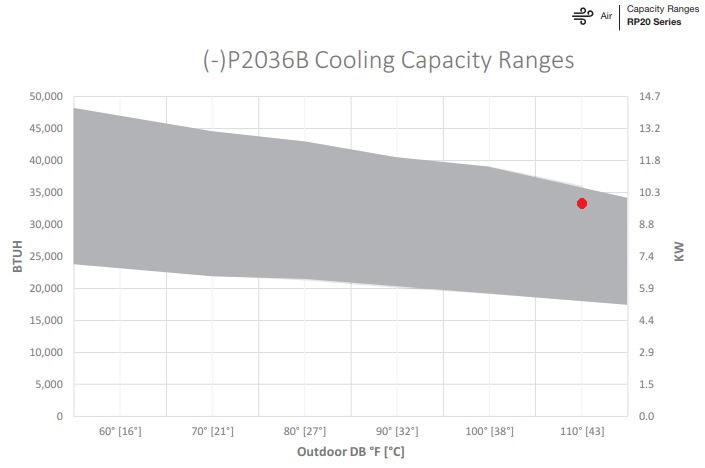What size heating/cooling unit does my home need?
What size heating/cooling unit does my home need?
If you find yourself shivering or sweating and madly mashing thermostat buttons without success, it might be time for a new heating or cooling unit. If your HVAC tech confirms that’s the case, it’s easy to just have it replaced with the same capacity unit. But what if you were never comfortable with the capacity of the unit you had? If it ran constantly, or started and stopped frequently, then those are signs that it may not have been sized correctly in the first place. We briefly touched on this subject in another article, but in the process of considering a new unit for my own home, I thought you would like to know about the factors to consider when sizing a new unit, and how you can do some calculations yourself (with free online programs).
Just as a car’s engine has to be sized correctly to provide the right horsepower for driving the car and its auxiliary functions like hauling heavy things and/or towing, a home’s heating and cooling unit must be sized correctly. Too small, and it will run constantly and struggle to keep the setpoint temperature. Too large, and it will start, quickly reach the set temperature, and shut down, sometimes “cycling” through the startup and shutdown frequently. Right-sizing the unit keeps the unit running for an optimal time without wasted power. It also allows the unit to remove more humidity from the air during the cooling season.
Your home is a complex environment! If you have an HVAC contractor that you trust to get you the right equipment, that’s a great resource to have. If you aren’t sure that he’s listening or will do his “homework” as well as he should, then it’s a good idea to do your own research. Normally when sizing a heating and cooling unit for a new construction home, architects or builders will perform what is known as a “Manual J” calculation. Manual J is the national ANSI-recognized (American National Standards Institute) standard for producing HVAC equipment sizing loads for single-family detached homes, small multi-unit structures, condominiums, town houses, and manufactured homes. A proper load calculation, performed in accordance with the Manual J 8th Edition procedure, is required by national building codes and most state and local jurisdictions. (Air Conditioning Contractors of America) Engineers usually use a specialized computer program and have training to input the right numbers, so performing a complete Manual J is usually not done by homeowners. However, not unlike the thousands of “hacks” you find online everyday, there are ways to approximate a Manual J yourself! Even though the computer or app is doing a lot of work for you, it’s only as good as the information you put into it. Let’s look at some of the factors that you will need to know about your home to get a moderately accurate answer.
Climate: Heating and cooling loads depend on what is going on outside, and decades of temperature highs, lows and averages can all be derived from your address or climate zone. You can get an idea of what climate zone you live in by checking out the map on this page.
Construction: Your home is unique, and the following features have impacts on your heating and cooling load by their different “R-values”, or the resistance to the flow of heat. The most convenient online estimators supply average R-values for each factor from the date of construction of the home and the standards that were in place at that time. For example, a home constructed in 2003 will have higher average R-values than one constructed in 1963. (For more about R-values, check out our article here!)
Type of foundation: crawlspace, basement, or slab, and the insulation level of each.
Floors: How many floors above grade (earth) do you have? What is the ceiling height of each floor?
Space above ceiling of uppermost floor: do you have a vented attic, no attic (ceiling is just below the roofline), or an unvented (conditioned) attic?
Walls: how are they constructed? Are they cinder blocks, wood frame, metal frame, etc.? What is the siding: brick, vinyl, wood, cement board, etc.?
Windows and doors: A full manual J will require the number and size of all windows and doors, but the estimators may only require a relative number of windows in a wall (none/low/med/high) and the type of window (single pane, double pane, etc.). Also, there should be a spot to include any skylights.
Exposure: the length of the sides facing each direction (north, south, east and west) are important.
Air-tightness: if you haven’t had a “blower-door test” performed on your house, an estimator program will allow you to guesstimate whether the air-sealing of your home is tight, average, or leaky.
Type of roof: Asphalt shingle, tile, and metal are popular inputs for this parameter.
HVAC: Now, it’s time to input what type of system you want to have. Most of these are geared toward central heating and cooling, so the following questions reflect that:
Ductwork: is it a ducted or ductless system? Is ductwork above, below, or in the conditioned space?
Design considerations: for example, the summer and winter indoor temperatures, and summer humidity (normally 50-55%).
How many occupants normally live in the home? If it’s only 2, Manual J will still call for 1 occupant per bedroom plus one in the living room (for example, a 3 bedroom home will have an input of 4 people).
Daily activity load: there may be opportunity to input the number of appliances or select an extra-large kitchen or extra refrigerator.
Now that you see all of the ways your home’s configuration and construction affects its heating and cooling load, it’s time to find free “apps” that can estimate that load with moderate effort and a good interface. I tried several programs to check my skills and the programs’ accuracy. For reference, my old system was rated at 3 tons, but because of high humidity it struggled to keep up on the hottest days. Here are some of the best programs:
CoolCalc.com: It’s free to create an account and input your “project”. You can also look at the loads that are calculated for free, however, you will need to pay to download the report that’s generated. The lowest payment is $20 for 5 downloads (which I found are needed as you can go back and “tweak” any inputs). This program had a neat feature of allowing you to look at a satellite image of your home and “trace” the first and second floor plans to estimate the square footage, but if your home is covered by too many trees or has a complex footprint, you can also input floors and rooms individually. By simply entering the date of construction, the program suggested average R-values, which really simplified input. With this calculator I received the report of 29,565 Btu cooling load and 48,043 Btu heating load (Btu’s are British Thermal Units; 12,000 Btu’s = 1 “ton” of capacity): this can be rounded to 3 tons of cooling and 4 tons of heating. This eight-minute video gives a quick tutorial on entering the necessary information to get a good result.
Loadcalc.net: This program did not have a fancy tab interface like CoolCalc, however it was more similar to a manual J in that square footage of the walls and windows were required (the most time-consuming element). Don’t try to do this one on your phone; you’ll need a spreadsheet if you have any number of windows in your home! Because of the input of wall and window exposure on the various walls, I do think this program produced the most accurate result, rendering 33,568 Btu’s cooling and 39,593 Btu’s heating load. It has decent instruction pages that explain a lot, and is completely free and savable so that you can go back and make changes easily. After you calculate your load, there is also a page to check that the size of the system you plan to purchase is within the specs of what you need for the load.
ServiceTitan.com: This is a super-simplified web page with only a few inputs, which turned out to wildly over-size the load: it generated 60,000 Btu (5 tons) recommended capacity and would not let me recalculate unless I entered my email address.
Remodelingcalculator.org: This calculator promised “NOT to over-specify the unit capacity…(because) most online tools give you a higher heat load estimate than you actually need for your home to sell you more expensive equipment.“ However, it was too simplified and definitely did oversize at 53,000 cooling Btu’s and 61,000 heating Btu’s. It also advised to verify the load with loadcalc.net before purchasing any equipment.
There is another factor that may influence sizing of your heating and cooling system: inverter heat pumps. Because my old system did not have inverter motors in it, it was limited to the speed settings of the motors it had. Inverter motors are a type of variable speed motor with infinite speeds, that will run at high speeds at the beginning to heat or cool quickly, then slow down to maintain the temperature, instead of constantly starting and stopping. This actually saves energy and keeps the temperature spot-on, instead of letting it wander a couple degrees up or down until the thermostat is triggered again. In humid climates, this type of system also removes moisture from the air more effectively because the blower runs longer at a lower speed, which is what is needed to remove more moisture from the air. If you check the performance curves for such a unit, like the Rheem RP20 Series, the rated capacity should fall well within the range of what the unit can do. In the case of their 3 ton unit, it should provide the calculated 34,000 Btus cooling right on up to 110 degF outside (see red dot on the chart). That’s a good thing.
Source: Rheem Heat Pump Specs
Because I plan on purchasing an inverter heat pump system with high SEER, am adding insulation in the attic, sealing an uninsulated duct chase and adding more weatherstripping and caulk around the house, I am going to opt for the 3 ton size again. It will definitely handle the cooling, which is the majority of the year here in the southeast, and is a bit undersized for the heating, but I’m not worried because we only have a few really cold days per year (30 degF and below). Before performing the calculations with these online programs, I wasn’t sure. But now, I can purchase with confidence that my new equipment will be up for the task. There’s so much technology online, it would be a shame not to take advantage of it. I hope this article helps you check out the real heating and cooling loads of your home, because even if you are not replacing equipment, it’s good to know if your equipment is performing well, or if there is a big hole in your building envelope somewhere (hope not!).
Photo by Pixasquare on Unsplash


